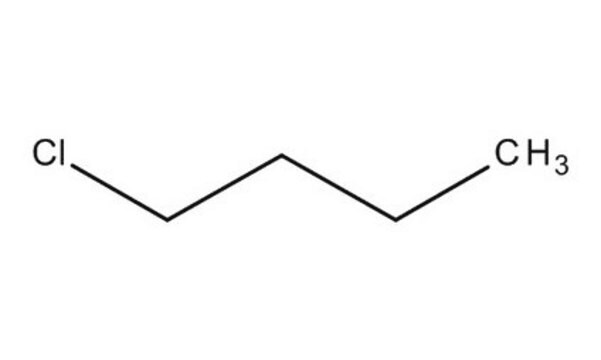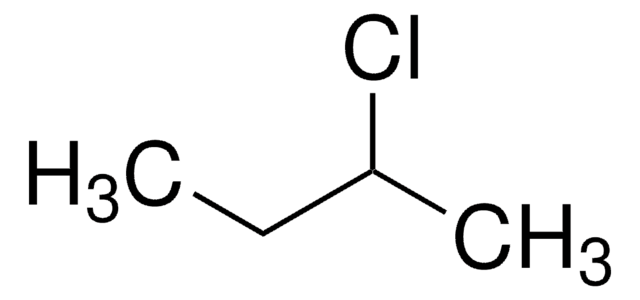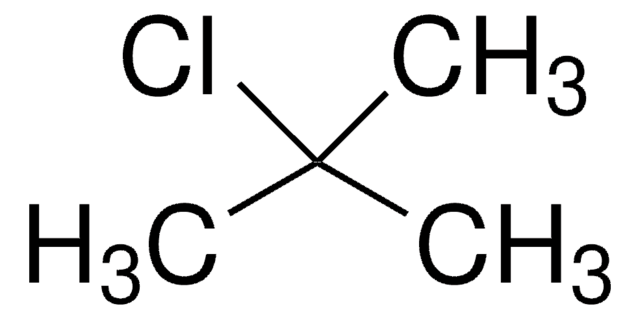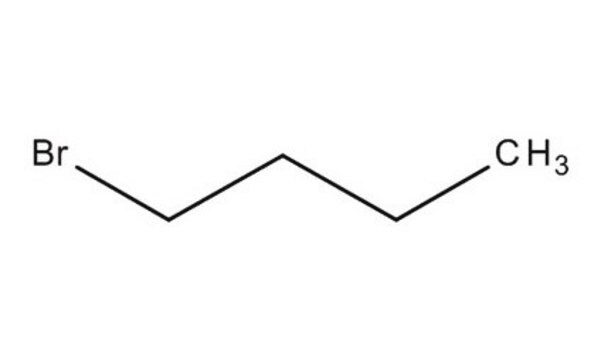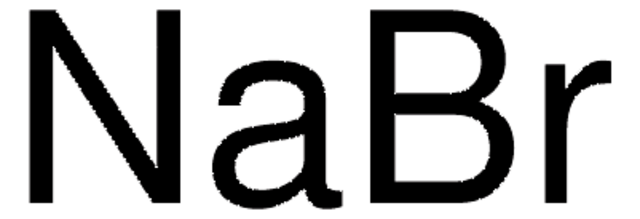1.01692
1-Chlorobutane
for liquid chromatography LiChrosolv®
Sinónimos:
1-Chlorobutane, n-Butyl chloride
About This Item
Productos recomendados
presión de vapor
110 hPa ( 20 °C)
Nivel de calidad
Línea del producto
LiChrosolv®
grado
isocratic
Ensayo
≥99.8% (GC)
Formulario
liquid
temp. de autoignición
280 °C
potencia
2200 mg/kg LD50, oral (Rat)
lim. expl.
1.8-10.1 % (v/v)
técnicas
HPLC: suitable
impurezas
≤0.0002 meq/g Acidity
≤0.0002 meq/g Alkalinity
≤0.01% Water
residuo de evap.
≤2.0 mg/L
transmitancia
227 nm, ≥60%
232 nm, ≥80%
250 nm, ≥98%
bp
79 °C/1013 hPa
mp
-123 °C
temperatura de transición
flash point -17 °C
densidad
0.886 g/cm3 at 20 °C
temp. de almacenamiento
2-30°C
InChI
1S/C4H9Cl/c1-2-3-4-5/h2-4H2,1H3
Clave InChI
VFWCMGCRMGJXDK-UHFFFAOYSA-N
Descripción general
Aplicación
- Cl atoms-initiated degradation of 1-Chlorobutane and 2-Chlorobutane: This study investigates the kinetics and product analysis of the degradation of 1-Chlorobutane initiated by chlorine atoms. It provides insights into the atmospheric implications of halogenated hydrocarbons, relevant for environmental monitoring and analysis (Kar & Rajakumar, 2023).
- Efficient Remediation of p-chloroaniline Contaminated Soil: Utilizing activated persulfate in the presence of nanosized zero-valent iron/biochar composites, this study demonstrates a method that might be adaptable for the remediation of environments contaminated with similar compounds like 1-Chlorobutane. This is particularly valuable for environmental scientists and lab technicians working on soil decontamination (Guo et al., 2023).
- Rate Coefficient and Mechanism of the OH-Initiated Degradation of 1-Chlorobutane: Focusing on the atmospheric degradation of 1-Chlorobutane by hydroxyl radicals, this research provides critical data for understanding the environmental impact and the chemical behavior of 1-Chlorobutane in the atmosphere, important for researchers in environmental science and atmospheric chemistry (Jara-Toro et al., 2020).
- Genetic programming of catalytic Pseudomonas putida biofilms for boosting biodegradation of haloalkanes: This research demonstrates the genetic modification of bacteria to enhance their ability to degrade haloalkanes, including 1-Chlorobutane. This could interest principle investigators in biotech and pharma researching new methods of biodegradation for industrial applications (Benedetti et al., 2016).
Nota de preparación
Nota de análisis
Identity (IR): conforms
Evaporation residue: ≤ 2.0 mg/l
Water: ≤ 0.01 %
Acidity: ≤ 0.0002 meq/g
Alkalinity: ≤ 0.0002 meq/g
Transmission (at 227 nm): ≥ 60 %
Transmission (at 232 nm): ≥ 80 %
Transmission (from 250 nm): ≥ 98 %
Filtered by 0.2 µm filter
Otras notas
Información legal
¿No encuentra el producto adecuado?
Pruebe nuestro Herramienta de selección de productos.
Palabra de señalización
Danger
Frases de peligro
Consejos de prudencia
Clasificaciones de peligro
Aquatic Chronic 3 - Asp. Tox. 1 - Flam. Liq. 2
Código de clase de almacenamiento
3 - Flammable liquids
Clase de riesgo para el agua (WGK)
WGK 2
Punto de inflamabilidad (°F)
10.4 °F - closed cup
Punto de inflamabilidad (°C)
-12 °C - closed cup
Certificados de análisis (COA)
Busque Certificados de análisis (COA) introduciendo el número de lote del producto. Los números de lote se encuentran en la etiqueta del producto después de las palabras «Lot» o «Batch»
¿Ya tiene este producto?
Encuentre la documentación para los productos que ha comprado recientemente en la Biblioteca de documentos.
Los clientes también vieron
Nuestro equipo de científicos tiene experiencia en todas las áreas de investigación: Ciencias de la vida, Ciencia de los materiales, Síntesis química, Cromatografía, Analítica y muchas otras.
Póngase en contacto con el Servicio técnico